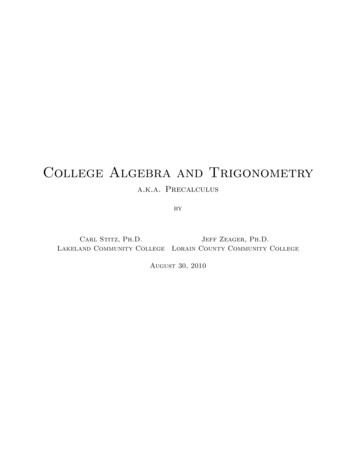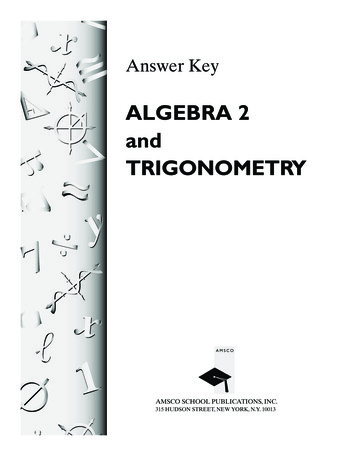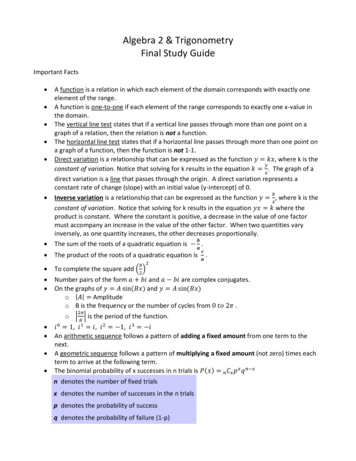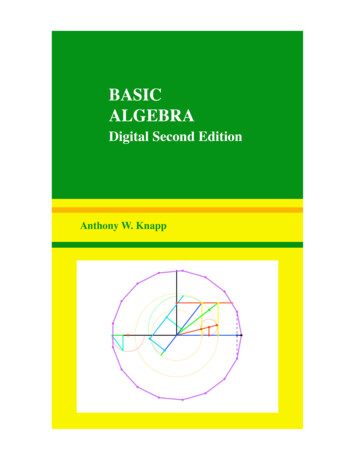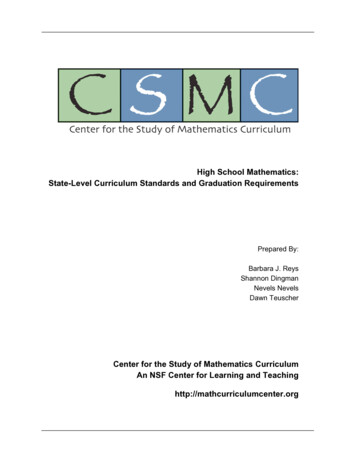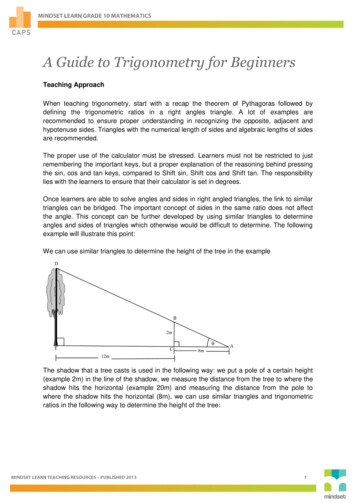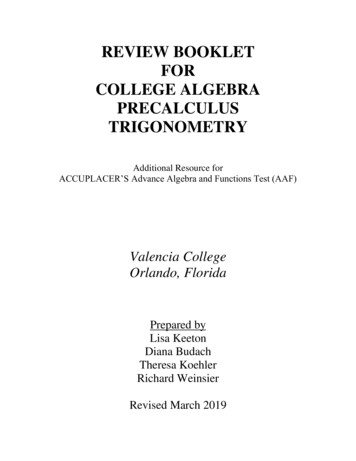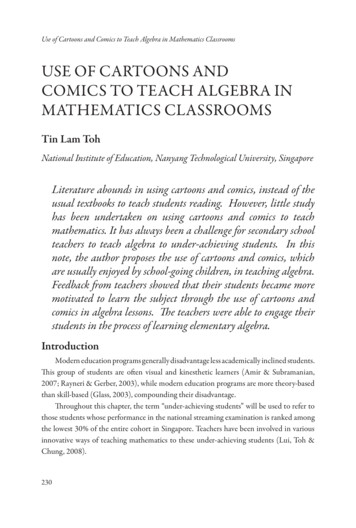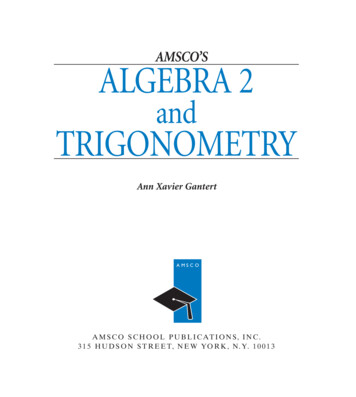
Transcription
14411FM.pgs8/12/081:46 PMPage iAMSCO’SALGEBRA 2andTRIGONOMETRYAnn Xavier GantertA M S C O S C H O O L P U B L I C AT I O N S, I N C .3 1 5 H U D S O N S T R E E T, N E W YO R K , N. Y. 1 0 0 1 3
14411FM.pgs8/12/081:46 PMPage iiDedicationTo Jessica Alexander and Uriel Avalos in gratitude for their invaluable work in preparing this text forpublication.Ann Xavier GantertThe author has been associated with mathematics education in New York State as a teacher and anauthor throughout the many changes of the past fifty years. She has worked as a consultant to theMathematics Bureau of the Department of Education in the development and writing of SequentialMathematics and has been a coauthor of Amsco’s Integrated Mathematics series, which accompanied thatcourse of study.Reviewers:Richard AuclairMathematics TeacherLa Salle SchoolAlbany, NYDomenic D’OrazioMathematics TeacherMidwood High SchoolBrooklyn, NYSteven J. BalasianoAssistant Principal,Supervision MathematicsCanarsie High SchoolBrooklyn, NYDebbie CalvinoMathematics Supervisor,Grades 7–12Valley Central High SchoolMontgomery, NYGeorge DrakatosMathematics TeacherBaldwin Senior High SchoolBaldwin, NYRonald HattarMathematics ChairpersonEastchester High SchoolEastchester, NYRaymond Scacalossi Jr.Mathematics CoordinatorManhasset High SchoolManhasset, NYText Designer: Nesbitt Graphics, Inc.Compositor: ICC MacmillanCover Design by Meghan J. ShupeCover Art by Radius Images (RM)Please visit our Web site at: www.amscopub.comWhen ordering this book, please specify:R 159 P or ALGEBRA 2 AND TRIGONOMETRY, Paperback orR 159 H or ALGEBRA 2 AND TRIGONOMETRY, HardboundISBN 978-1-56765-703-6 (Paperback edition)NYC Item 56765-703-5 (Paperback edition)ISBN 978-1-56765-702-9 (Hardbound edition)NYC Item 56765-702-8 (Hardbound edition)Copyright 2009 by Amsco School Publications, Inc.No part of this book may be reproduced in any form without written permission from the publisher.Printed in the United States of America1 2 3 4 5 6 7 8 9 1014 13 12 11 10 09 08
14411FM.pgs8/12/081:46 PMPage iiiPREFACEAlgebra 2 and Trigonometry is a new text for a course in intermediate algebra andtrigonometry that continues the approach that has made Amsco a leader in presenting mathematics in a modern, integrated manner. Over the last decade, thisapproach has undergone numerous changes and refinements to keep pace withever-changing technology.This textbook is the final book in the three-part series in which Amsco parallelsthe integrated approach to the teaching of high school mathematics promoted bythe National Council of Teachers of Mathematics in its Principles and Standards forSchool Mathematics and mandated by the New York State Board of Regents in theMathematics Core Curriculum. The text presents a range of materials and explanations that are guidelines for achieving a high level of excellence in their understanding of mathematics.In this book: The real numbers are reviewed and the understanding of operations with irrational numbers, particularly radicals, is expanded. The graphing calculator continues to be used as a routine tool in the study ofmathematics. Its use enables the student to solve problems that require computationthat more realistically reflects the real world. The use of the calculator replaces theneed for tables in the study of trigonometry and logarithms. Coordinate geometry continues to be an integral part of the visualization ofalgebraic and trigonometric relationships. Functions represent a unifying concept throughout. The algebraic functionsintroduced in Integrated Algebra 1 are reviewed, and exponential, logarithmic, andtrigonometric functions are presented. Algebraic skills from Integrated Algebra 1 are maintained, strengthened, andexpanded as both a holistic approach to mathematics and as a bridge to advancedstudies. Statistics includes the use of the graphing calculator to reexamine range, quartiles, and interquartile range, to introduce measures of dispersion such as varianceand standard deviation, and to determine the curve that best represents a set ofbivariate data.iii
14411FM.pgs8/12/08iv1:46 PMPage ivPREFACE Integration of geometry, algebra, trigonometry, statistics, and other branches ofmathematics begun in Integrated Algebra 1 and Geometry is continued and furtherexpanded. Exercises are divided into three categories. Writing About Mathematics encourages the student to reflect on and justify mathematical conjectures, to discovercounterexamples, and to express mathematical ideas in his or her own words.Developing Skills provides routine practice exercises that enable the student andteacher to evaluate the student’s ability to both manipulate mathematical symbolsand understand mathematical relationships. Applying Skills provides exercises inwhich the new ideas of each section, together with previously learned skills, are usedto solve problems that reflect real-life situations. Problem solving, a primary goal of all learning standards, is emphasizedthroughout the text. Students are challenged to apply what has been learned to thesolution of both routine and non-routine problems. Enrichment is stressed both in the text and in the Teacher’s Manual wheremany suggestion are given for teaching strategies and alternative assessment. TheManual provides opportunities for extended tasks and hands-on activities.Reproducible Enrichment Activities that challenge students to explore topics ingreater depth are provided in each chapter of the Manual.In this text, the real number system is expanded to include the complex numbers, and algebraic, exponential, logarithmic, and trigonometric functions are investigated. The student is helped to understand the many branches of mathematics, toappreciate the common threads that link these branches, and to recognize theirinterdependence.The intent of the author is to make this book of greatest service to the averagestudent through detailed explanations and multiple examples. Each section providescareful step-by-step procedures for solving routine exercises as well as the nonroutine applications of the material. Sufficient enrichment material is included tochallenge students of all abilities.Specifically: Concepts are carefully developed using appropriate language and mathematical symbolism. General principles are stated clearly and concisely. Numerous examples serve as models for students with detailed explanations ofthe mathematical concepts that underlie the solution. Alternative approaches aresuggested where appropriate. Varied and carefully graded exercises are given in abundance to develop skillsand to encourage the application of those skills. Additional enrichment materialschallenge the most capable students.This text is offered so that teachers may effectively continue to help students tocomprehend, master, and enjoy mathematics as they progress in their education.
14411FM.pgs8/12/081:46 PMPage vCONTENTSChapter 1THE INTEGERS1-11-21-31-41-51-61-71-81Whole Numbers, Integers, and the Number LineWriting and Solving Number SentencesAdding PolynomialsSolving Absolute Value Equations and InequalitiesMultiplying PolynomialsFactoring PolynomialsQuadratic Equations with Integral RootsQuadratic InequalitiesChapter SummaryVocabularyReview Exercises2591317222730353637Chapter 2THE RATIONAL 4747577Rational NumbersSimplifying Rational ExpressionsMultiplying and Dividing Rational ExpressionsAdding and Subtracting Rational ExpressionsRatio and ProportionComplex Rational ExpressionsSolving Rational EquationsSolving Rational InequalitiesChapter SummaryVocabularyReview ExercisesCumulative ReviewChapter 3REAL NUMBERS AND RADICALS3-13-23-3The Real Numbers and Absolute ValueRoots and RadicalsSimplifying Radicals79808488v
14411FM.pgs8/12/08vi1:46 PMPage viCONTENTS3-43-53-63-73-8Adding and Subtracting RadicalsMultiplying RadicalsDividing RadicalsRationalizing a DenominatorSolving Radical EquationsChapter SummaryVocabularyReview ExercisesCumulative Review9498102104108113114114117Chapter 4RELATIONS AND FUNCTIONS4-14-24-34-44-54-64-74-84-94-10Relations and FunctionsFunction NotationLinear Functions and Direct VariationAbsolute Value FunctionsPolynomial FunctionsThe Algebra of FunctionsComposition of FunctionsInverse FunctionsCirclesInverse VariationChapter SummaryVocabularyReview ExercisesCumulative 4Chapter 5QUADRATIC FUNCTIONS AND COMPLEX NUMBERS5-15-25-35-45-55-65-75-85-9Real Roots of a Quadratic EquationThe Quadratic FormulaThe DiscriminantThe Complex NumbersOperations with Complex NumbersComplex Roots of a Quadratic EquationSum and Product of the Roots of a Quadratic EquationSolving Higher Degree Polynomial EquationsSolutions of Systems of Equations and InequalitiesChapter SummaryVocabularyReview ExercisesCumulative Review186187193198203209217219224229239240241244
14411FM.pgs8/12/081:46 PMPage viiCONTENTSviiChapter 6SEQUENCES AND SERIES6-16-26-36-46-56-66-7SequencesArithmetic SequencesSigma NotationArithmetic SeriesGeometric SequencesGeometric SeriesInfinite SeriesChapter SummaryVocabularyReview ExercisesCumulative Review247248252257262266270273279280280283Chapter 7EXPONENTIAL FUNCTIONS7-17-27-37-47-57-67-7Laws of ExponentsZero and Negative ExponentsFractional ExponentsExponential Functions and Their GraphsSolving Equations Involving ExponentsSolving Exponential EquationsApplications of Exponential FunctionsChapter SummaryVocabularyReview ExercisesCumulative Review286287289293298304306308314315315316Chapter 8LOGARITHMIC FUNCTIONS8-18-28-38-48-58-68-7Inverse of an Exponential FunctionLogarithmic Form of an Exponential EquationLogarithmic RelationshipsCommon LogarithmsNatural LogarithmsExponential EquationsLogarithmic EquationsChapter SummaryVocabularyReview ExercisesCumulative Review319320324327332336340344347347348351
14411FM.pgs8/12/08viii1:46 PMPage viiiCONTENTSChapter 9TRIGONOMETRIC FUNCTIONS9-19-29-39-49-59-69-79-8Trigonometry of the Right TriangleAngles and Arcs as RotationsThe Unit Circle, Sine, and CosineThe Tangent FunctionThe Reciprocal Trigonometric FunctionsFunction Values of Special AnglesFunction Values from the CalculatorReference Angles and the CalculatorChapter SummaryVocabularyReview ExercisesCumulative er 10MORE TRIGONOMETRIC FUNCTIONS10-110-210-310-410-510-6Radian MeasureTrigonometric Function Values and Radian MeasurePythagorean IdentitiesDomain and Range of Trigonometric FunctionsInverse Trigonometric FunctionsCofunctionsChapter SummaryVocabularyReview ExercisesCumulative Review399400406411414419425428430430431Chapter 11GRAPHS OF TRIGONOMETRIC FUNCTIONS11-111-211-311-411-511-611-711-8Graph of the Sine FunctionGraph of the Cosine FunctionAmplitude, Period, and Phase ShiftWriting the Equation of a Sine or Cosine GraphGraph of the Tangent FunctionGraphs of the Reciprocal FunctionsGraphs of Inverse Trigonometric FunctionsSketching Trigonometric GraphsChapter SummaryVocabularyReview ExercisesCumulative Review434435442447455460463468472475476476479
14411FM.pgs8/12/081:46 PMPage ixCONTENTSixChapter 12TRIGONOMETRIC IDENTITIES12-112-212-312-412-512-612-712-8Basic IdentitiesProving an IdentityCosine (A 2 B)Cosine (A 1 B)Sine (A 2 B) and Sine (A 1 B)Tangent (A 2 B) and Tangent (A 1 B)Functions of 2AFunctions of 12AChapter SummaryVocabularyReview ExercisesCumulative er 13TRIGONOMETRIC EQUATIONS13-113-213-313-413-5First-Degree Trigonometric EquationsUsing Factoring to Solve Trigonometric EquationsUsing the Quadratic Formula to Solve Trigonometric EquationsUsing Substitution to Solve Trigonometric EquationsInvolving More Than One FunctionUsing Substitution to Solve Trigonometric EquationsInvolving Different Angle MeasuresChapter SummaryVocabularyReview ExercisesCumulative Review518519526530534538542542543545Chapter 14TRIGONOMETRIC APPLICATIONS14-114-214-314-414-514-614-7Similar TrianglesLaw of CosinesUsing the Law of Cosines to Find Angle MeasureArea of a TriangleLaw of SinesThe Ambiguous CaseSolving TrianglesChapter SummaryVocabularyReview ExercisesCumulative Review547548552557559564569575581582582585
14411FM.pgs8/12/08x1:46 PMPage xCONTENTSChapter -10587Univariate StatisticsMeasures of Central TendencyMeasures of Central Tendency for Grouped DataMeasures of DispersionVariance and Standard DeviationNormal DistributionBivariate StatisticsCorrelation CoefficientNon-Linear RegressionInterpolation and ExtrapolationChapter SummaryVocabularyReview ExercisesCumulative apter 16PROBABILITY AND THE BINOMIAL THEOREM16-116-216-316-416-516-6INDEXThe Counting PrinciplePermutations and CombinationsProbabilityProbability with Two OutcomesBinomial Probability and the Normal CurveThe Binomial TheoremChapter SummaryVocabularyReview ExercisesCumulative Review672673678687695701708711713713715718
14411C01.pgs8/12/081:46 PMPage 1CHAPTERTHEINTEGERSIn golf tournaments, a player’s standing after eachhole is often recorded on the leaderboard as the number of strokes above or below a standard for that holecalled a par. A player’s standing is a positive number ifthe number of strokes used was greater than par anda negative number if the number of strokes used wasless than par. For example, if par for the first hole is 4strokes and a player uses only 3, the player’s standingafter playing the first hole is 21.Rosie Barbi is playing in an amateur tournament.Her standing is recorded as 2 below par (22) after sixteen holes. She shoots 2 below par on the seventeenthhole and 1 above par on the eighteenth. What isRosie’s standing after eighteen holes? Nancy Taylor,who is her closest opponent, has a standing of 1 belowpar (21) after sixteen holes, shoots 1 below par onthe seventeenth hole and 1 below par on the eighteenth.What is Nancy’s standing after eighteen holes?In this chapter, we will review the set of integersand the way in which the integers are used in algebraicexpressions, equations, and inequalities.1CHAPTERTABLE OF CONTENTS1-1 Whole Numbers, Integers,and the Number Line1-2 Writing and Solving NumberSentences1-3 Adding Polynomials1-4 Solving Absolute ValueEquations and Inequalities1-5 Multiplying Polynomials1-6 Factoring Polynomials1-7 Quadratic Equations withIntegral Roots1-8 Quadratic InequalitiesChapter SummaryVocabularyReview Exercises1
14411C01.pgs8/12/0821:46 PMPage 2The Integers1-1 WHOLE NUMBERS, INTEGERS, AND THE NUMBER LINEThe first numbers that we learned as children and probably the first numbersused by humankind are the natural numbers. Most of us began our journey ofdiscovery of the mathematical world by counting, the process that lists, in order,the names of the natural numbers or the counting numbers. When we combinethe natural numbers with the number 0, we form the set of whole numbers:{0, 1, 2, 3, 4, 5, 6, . . . }These numbers can be displayed as points on the number line:0123456789The number line shows us the order of the whole numbers; 5 is to the rightof 2 on the number line because 5 2, and 3 is to the left of 8 on the numberline because 3 8. The number 0 is the smallest whole number. There is no largest whole number.The temperature on a winter day may be two degrees above zero or twodegrees below zero. The altitude of the highest point in North America is 20,320feet above sea level and of the lowest point is 282 feet below sea level. We represent numbers less than zero by extending the number line to the left of zero,that is, to numbers that are less than zero, and by assigning to every whole number a an opposite, 2a, such that a 1 (2a) 5 0.DEFINITIONThe opposite or additive inverse of a is 2a, the number such thata 1 (2a) 5 0.The set of integers is the union of the set of whole numbers and their opposites. The set of non-zero whole numbers is the positive integers and the opposites of the positive integers are the negative integers. 6 5 4 3 2 10123456Let a, b, and c represent elements of the set of integers. Under the operation of addition, the following properties are true:1. Addition is closed:a 1 b is an integer2. Addition is commutative:a1b5b1a3. Addition is associative:(a 1 b) 1 c 5 a 1 (b 1 c)4. Addition has an identity element, 0:a105a5. Every integer has an inverse:a 1 (2a) 5 0
14411C01.pgs8/12/081:46 PMPage 3Whole Numbers, Integers, and the Number Line3We say that the integers form a commutative group under addition becausethe five properties listed above are true for the set of integers.SubtractionDEFINITIONa 2 b 5 c if and only if b 1 c 5 a.Solve the equation b 1 c 5 a for c:b1c5a2b 1 b 1 c 5 a 1 (2b)c 5 a 1 (2b)Therefore, a 2 b a 1 (2b).Absolute ValueA number, a, and its opposite, 2a, are the same distance from zero on the number line. When that distance is written as a positive number, it is called theabsolute value of a. If a 0, then a 5 a 2 0 5 a If a 0, then a 5 0 2 a 5 2aNote: When a 0, a is a negative number and its opposite, 2a, is a positivenumber.For instance, 5 0. Therefore, 5 5 5 2 0 5 5.25 0. Therefore, –5 5 0 2 (25) 5 5.We can also say that a 5 –a 5 a or 2a, whichever is positive.EXAMPLE 1Show that the opposite of 2b is b.Solution The opposite of b, 2b, is the number such that b 1 (2b) 5 0.Since addition is commutative, b 1 (2b) 5 (2b) 1 b 5 0.The opposite of 2b is the number such that (2b) 1 b 5 0. Therefore, theopposite of 2b is b.
14411C01.pgs8/12/0841:46 PMPage 4The IntegersExercisesWriting About Mathematics1. Tina is three years old and knows how to count. Explain how you would show Tina that3 1 2 5 5.2. Greg said that a 2 b 5 b 2 a . Do you agree with Greg? Explain why or why not.Developing SkillsIn 3–14, find the value of each given expression.3. 6 4. 212 5. 8 2 3 6. 3 2 8 7. 5 1 (212) 8. 212 1 (2(25)) 9. 4 2 6 1 (22) 12. 8 2 22 2 2 10. 8 1 (10 2 18) 11. 3 2 3 13. 2( 22 1 3 )14. 4 2 3 1 21 In 15–18, use the definition of subtraction to write each subtraction as a sum.15. 8 2 5 5 316. 7 2 (22) 5 917. 22 2 5 5 2718. 28 2 (25) 5 2319. Two distinct points on the number line represent the numbers a and b.If 5 2 a 5 5 2 b 5 6, what are the values of a and b?Applying SkillsIn 20–22, Mrs. Menendez uses computer software to record her checking account balance. Each timethat she makes an entry, the amount that she enters is added to her balance.20. If she writes a check for 20, how should she enter this amount?21. Mrs. Menendez had a balance of 52 in her checking account and wrote a check for 75.a. How should she enter the 75?b. How should her new balance be recorded?22. After writing the 75 check, Mrs. Menendez realized that she would be overdrawn when thecheck was paid by the bank so she transferred 100 from her savings account to her checking account. How should the 100 be entered in her computer program?
14411C01.pgs8/12/081:46 PMPage 5Writing and Solving Number Sentences51-2 WRITING AND SOLVING NUMBER SENTENCESEquationsA sentence that involves numerical quantities can often be written in the symbols of algebra as an equation. For example, let x represent any number. Thenthe sentence “Three less than twice a number is 15” can be written as:2x 2 3 5 15When we translate from one language to another, word order often must bechanged in accordance with the rules of the language into which we are translating. Here we must change the word order for “three less than twice a number” to match the correct order of operations.The domain is the set of numbers that can replace the variable in an algebraic expression. A number from the domain that makes an equation true is asolution or root of the equation. We can find the solution of an equation by writing a sequence of equivalent equations, or equations that have the same solution set, until we arrive at an equation whose solution set is evident. We findequivalent equations by changing both sides of the given equation in the sameway. To do this, we use the following properties of equality:Properties of Equality Addition Property of Equality: If equals are added to equals, the sumsare equal. Subtraction Property of Equality: If equals are subtracted fromequals, the differences are equal. Multiplication Property of Equality: If equals are multiplied by equals,the products are equal. Division Property of Equality: If equals are divided by non-zeroequals, the quotients are equal.On the left side of the equation 2x 2 3 5 15, the variable is multiplied by 2and then 3 is subtracted from the product. We will simplify the left side of theequation by “undoing” these operations in reverse order, that is, we will first add3 and then divide by 2. We can check that the number we found is a root of thegiven equation by showing that when it replaces x, it gives us a correct statementof equality.2x 2 3 5 152x 2 3 1 3 5 15 1 32x 5 18x59Check2x 2 3 5 15?2(9) 2 3 5 1515 5 15
14411C01.pgs8/12/0861:46 PMPage 6The IntegersOften the definition of a mathematical term or a formula is needed to writean equation as the following example demonstrates:EXAMPLE 1Let A be an angle such that the complement of A is 6 more than twice themeasure of A. Find the measure of A and its complement.Solution To write an equation to find A, we must know that two angles are complements if the sum of their measures is 90 .Let x 5 the measure of A.Then 2x 1 6 5 the measure of the complement of A.The sum of the measures of an angle and of its complement is 90.x 1 2x 1 6 5 903x 1 6 5 903x5 84x5 282x 1 6 5 2(28) 1 6 5 62Therefore, the measure of A is 28 and the measure of its complement is 62.Check The sum of the measures of A and its complement is 28 1 62 or 90. Answer m A 5 28; the measure of the complement of A is 62.EXAMPLE 2Find the solution of the following equation: 6x 2 3 5 15.Solution Since 15 5 215 5 15, the algebraic expression 6x 2 3 can be equal to 15 orto 215.6x 2 3 5 156x 2 3 1 3 5 15 1 3or6x 2 3 5 2156x 2 3 1 3 5 215 1 36x 5 186x 5 212x53x 5 22Check: x 5 3 6x 2 3 5 15? 6(3) 2 3 5 15 15 5 15 Answer The solution set is {3, 22}.Check: x 5 22 6x 2 3 5 15? 6(22) 2 3 5 15 215 5 15
14411C01.pgs8/12/081:46 PMPage 7Writing and Solving Number Sentences7InequalitiesA number sentence can often be an inequality. To find the solution set of aninequality, we use methods similar to those that we use to solve equations. Weneed the following two properties of inequality:Properties of Inequality Addition and Subtraction Property of Inequality: If equals are addedto or subtracted from unequals, the sums or differences are unequal inthe same order. Multiplication and Division Property of Inequality: If unequals aremultiplied or divided by positive equals, the products or quotients areunequal in the same order. If unequals are multiplied or divided bynegative equals, the products or quotients are unequal in the oppositeorder.EXAMPLE 3Find all positive integers that are solutions of the inequality 4n 1 7 27.Solution We solve this inequality by using a procedure similar to that used for solvingan equation.4n 1 7 , 274n 1 7 1 (27) , 27 1 (27)4n , 20n,5Since n is a positive integer, the solution set is {1, 2, 3, 4}. Answer
14411C01.pgs8/15/0883:14 PMPage 8The IntegersEXAMPLE 4Polly has 210 in her checking account. After writing a check for tickets to a concert, she has less than 140 in her account but she is not overdrawn. If eachticket cost 35, how many tickets could she have bought?Solution Let x 5 the number of tickets.The cost of x tickets, 35x, will be subtracted from 210, the amount in herchecking account. Since she is not overdrawn after writing the check, her balance is at least 0 and less than 140.0 210 2 35x 140–210–210–210 2210235 6 –210Add 2210 to each member of the inequality.2 35x 270235x235 270235x 2Divide each member of the inequality by 235.Note that dividing by a negative numberreverses the order of the inequality.Polly bought more than 2 tickets but at most 6.Answer Polly bought 3, 4, 5, or 6 tickets.ExercisesWriting About Mathematics1. Explain why the solution set of the equation 12 2 x 5 15 is the empty set.2. Are 24x 12 and x 23 equivalent inequalities? Justify your answer.Developing SkillsIn 3–17, solve each equation or inequality. Each solution is an integer.3. 5x 1 4 5 394. 7x 1 18 5 395. 3b 1 18 5 126. 12 2 3y 5 187. 9a 2 7 5 298. 13 2 x 5 159. 2x 1 4 5 2210. 3 2 y 5 811. 4a 2 12 5 1612. 2x 1 3 2 8 5 1513. 7a 1 3 1714. 9 2 2b 115. 3 4x 2 1 1116. 0 , x 2 3 , 417. 5 4b 1 9 17Applying SkillsIn 18–23, write and solve an equation or an inequality to solve the problem.18. Peter had 156 cents in coins. After he bought 3 packs of gum he had no more than 9 centsleft. What is the minimum cost of a pack of gum?
8/12/081:46 PMPage 9Adding Polynomials919. In an algebra class, 3 students are working on a special project and the remaining studentsare working in groups of five. If there are 18 students in class, how many groups of five arethere?20. Andy paid a reservation fee of 8 plus 12 a night to board her cat while she was on vacation. If Andy paid 80 to board her cat, how many nights was Andy on vacation?21. At a parking garage, parking costs 5 for the first hour and 3 for each additional hour orpart of an hour. Mr. Kanesha paid 44 for parking on Monday. For how many hours did Mr.Kanesha park his car?22. Kim wants to buy an azalea plant for 19 and some delphinium plants for 5 each. She wantsto spend less than 49 for the plants. At most how many delphinium plants can she buy?23. To prepare for a tennis match and have enough time for schoolwork, Priscilla can practiceno more than 14 hours. If she practices the same length of time on Monday through Friday,and then spends 4 hours on Saturday, what is the most time she can practice on Wednesday?1-3 ADDING POLYNOMIALSA monomial is a constant, a variable, or the product of constants and variables.Each algebraic expression, 3, a, ab, 22a2, is a monomial.Exponent 3a4 14411C01.pgsCoefficientBaseA polynomial is the sum of monomials. Each monomial is a term of thepolynomial. The expressions 3a2 1 7a 2 2 is a polynomial over the set of integers since all of the numerical coefficients are integers. For any integral value ofa, 3a2 1 7a 2 2 has an integral value. For example, if a 5 22, then:3a2 1 7a 2 2 5 3(22)2 1 7(22) 225 3(4) 1 7(22) 2 25 12 2 14 2 25 24The same properties that are true for integers are true for polynomials: wecan use the commutative, associative, and distributive properties when workingwith polynomials. For example:(3a2 1 5a) 1 (6 2 7a) 5 (3a2 1 5a) 1 (27a 1 6)Commutative Property2Associative Property2Distributive Property5 3a 1 (5a 2 7a) 1 65 3a 1 (5 2 7)a 1 625 3a 2 2a 1 6
14411C01.pgs8/12/08101:46 PMPage 10The IntegersNote: When the two polynomials are added, the two terms that have the samepower of the same variable factor are combined into a single term.Two terms that have the same variable and exponent or are both numbersare called similar terms or like terms. The sum of similar terms is a monomial.3a2 1 5a227ab 1 3abx3 1 4x35 (3 1 5)a25 (27 1 3)ab5 (1 1 4)x35 8a25 24ab5 5x3Two monomials that are not similar terms cannot be combined. For example, 4x3 and 3x2 are not similar terms and the sum 4x3 1 3x2 is not a monomial.A polynomial in simplest form that has two terms is a binomial. A polynomialin simplest form that has three terms is a trinomial.Solving Equations and InequalitiesAn equation or inequality often has a variable term on both sides. To solve suchan equation or inequality, we must first write an equivalent equation or inequality with the variable on only one side.For example, to solve the inequality 5x 2 7 3x 1 9, we will first write anequivalent inequality that does not have a variable in the right side. Add theopposite of 3x, 23x, to both sides. The terms 3x and 23x are similar terms whosesum is 0.5x 2 7 3x 1 923x 1 5x 2 7 23x 1 3x 1 92x 2 7 92x 2 7 1 7 9 1 72x 16x 8Add 23x, the opposite of 3x, to both sides.23x 1 3x 5 (23 1 3)x 5 0x 5 0Add 7, the opposite of 27, to both sides.Divide both sides by 2. Dividing by apositive does not reverse the inequality.If x is an integer, then the solution set is {9, 10, 11, 12, 13, . . . }.EXAMPLE 1a. Find the sum of x3 2 5x 1 9 and x 2 3x3.b. Find the value of each of the given polynomials and the value of their sumwhen x 5 24.Solution a. The commutative and associative properties allow us to change the orderand the grouping of the terms.
14411C01.pgs8/12/081:46 PMPage 11Adding Polynomials11(x3 2 5x 1 9) 1 (x 2 3x3) 5 (x3 2 3x3) 1 (25x 1 x) 1 95 (1 2 3)x3 1 (25 1 1)x 1 95 22x3 2 4x 1 9 Answerb.x3 2 5x 1 9x 2 3x322x3 2 4x 1 95 (24) 3 2 5(24) 1 95 (24) 2 3(24) 35 22(24) 3 2 4(24) 1 95 264 1 20 1 95 24 1 1925 128 1 16 1 95 235 Answer5 188 Answer5 153 AnswerEXAMPLE 2Subtract (3b4 1 b 1 3) from (b4 2 5b 1 3) and write the difference as a polynomial in simplest form.Solution Subtract (3b4 1 b 1 3) from (b4 2 5b 1 3) by adding the opposite of(3b4 1 b 1 3) to (b4 2 5b 1 3).(b4 2 5b 1 3) 2 (3b4 1 b 1 3) 5 (b4 2 5b 1 3) 1 (23b4 2 b 2 3)5 (b4 2 3b4) 1 (25b 2 b) 1 (3 2 3)5 22b4 2 6b AnswerEXAMPLE 3Pam is three times as old as Jody. In five years, Pam will be twice as old as Jody.How old are Pam and Jody now?SolutionLet x 5 Jody’s age now3x 5 Pam’s age nowx 1 5 5 Jody’s age in 5 years3x 1 5 5 Pam’s age in 5 yearsPam’s age in 5 years will be twice Jody’s age in 5 years.3x 1 552(x 1 5)3x 1 552x 1 1022x 1 3x 1 5x15Answer Jody is 5 and Pam is 15.5 2 2x 1 2x 1 1005x 1 5 2 5510 2 5x553x5151 10
14411C01.pgs8/12/08121:46 PMPage 12The IntegersExercisesWriting About Mathematics1. Danielle said that there is no integer that makes the inequality 2x 1 1 x true. Do youagree with Danielle? Explain your answer.2. A binomial is a polynomial with two terms and a trinomial is a polynomial with three term
Algebra 2 and Trigonometry is a new text for a course in intermediate algebra and trigonometry that continues the approach that has made Amsco a leader in pre-senting mathematics in a modern, integrated manner. Over the last decade, this approach has undergone numerous changes an


